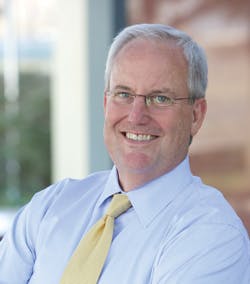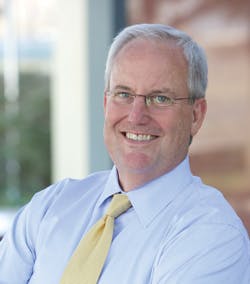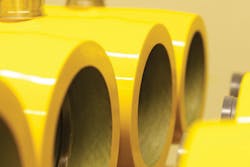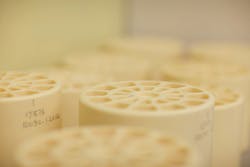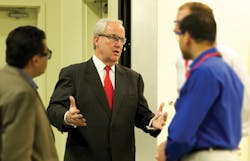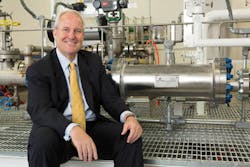When Tom Rooney joined Energy Recovery Inc (ERI) in 2011 the company was facing a tough desalination market. Here he speaks to Tom Freyberg about how he has grown the company to a 90% market share in two years and why divesting into other markets will be key for future growth.
Before we start, I want to ask you a question that Tom Rooney, CEO of ERI, presents to MBA students when giving presentations: is ERI a company in the water industry or the energy industry? Have a think about the answer and we'll come back to it later.
When Rooney joined ERI in 2011, you could say the odds were stacked against him. Following the decline of the desalination market from its peak in 2007, ERI's market share had dropped to 50%.
To most CEOs around the world, this figure would be one to boast about. To ERI, this was simply not good enough. The company was used to controlling nearly three quarters of the energy recovery market back in 2008 with a 70% share.
The company's flagship product, and one it has sold 14,000 of globally, is the PX Pressure Exchanger devices. In short, these devices work in membrane-based desalination processes by recovering energy from the membrane reject stream and feeding it back to the SWRO process. Around 95-97% of ERI's revenue comes from this series of products, with the remaining 3-5% is generated from the sale of booster pumps sold alongside the pressure exchangers.
Rough and tumble corporate turnaround
It wasn't just the slowing desalination market that was to blame but also increased competition. In 2009 pump and valve company Flowserve bought Swiss company CALDER to supply energy recovery devices.
"While we saw a double up going from 2000-2008, we had a double negative from 2008-2011, that is to say fierce competition," Rooney tells WWi magazine. "It drove our market share down to 50%."
To fix the problems, ERI decided to bring in Rooney who had started getting the reputation as a "turnaround CEO" from his time at Insituform. He was called into the piping company back in 2003 to carry out a "rough and tumble corporate turnaround".
He describes the company at the time as facing: "Very challenging problems with its operation management – everything from a criminally high level of on the job deaths prior to me getting there, to losing market share, to losing money."
The results speak for themselves. The CEO says he fixed the death rate at Insituform (now called Aegion), got the company profitable again and drove back the market share from 35% to 60%.
Despite the apparent rough and tumble approach, Rooney describes his time there as a "lot of fun" where he "spent a great amount of time dealing with ministerial water policy makers, gaining a key understanding of why the water industry behaves the way it does".
Three-pronged attack at ERI
The question everyone was asking in 2011 was whether the CEO could indeed strike twice with his new appointment at ERI. And how could he bring experience from a piping company and also a solar energy company into a firm known for its energy recovery devices in the seawater reverse osmosis (SWRO) market.
Rooney was clearly not hanging about from the start. From day one he came in with a three-pronged strategy: reduce costs in the company, make manufacturing more efficient and thirdly expand into new markets.
As he later calls it, "going back to block and tackle basics of great operations management". In summary this could be read as: creating a leaner and meaner global organisation.
Such operations management included consolidating manufacturing of its turbo-charger pumps from an acquired Michigan facility to where its pressure exchangers are made in California. Two manufacturing facilities effectively reduced to one.
"In tough times you have to get lean," he says.
Such leanness involved expected redundancies - "not everyone has an administrative assistant anymore" and addressing manufacturing costs.
The CEO is proud of the results two years down the line. "It's worked for us - we rebounded and about $43 million in revenue, with a 90% market share and even our gross margins have rebounded. We saw gross margins of about 28% in 2011 – which again a lot of industrial concerns would love to have 28% gross margins. For us, this is not where we knew we would operate. In the second quarter of 2013 we actually reported close to 62% gross margins."
Reducing SWRO's sound and energy waves
Despite the turnaround, the question has to be asked of whether when reducing manufacturing costs, has it sacrificed product quality – a reputation ERI had been building itself on?
"If you sacrifice client satisfaction in order to save another $100 then you've really lost the game," he says.
That'll be a "no" then. While the main noise associated with desalination plants is from high-pressure pumps, it was actually upon addressing a client request for a quieter energy recovery product that ERI says it has improved product efficiency.
"For the first decade of selling those devices, one of the only things clients were annoyed about was that they were loud – they made a noise because there was water pulsation going on inside, like a water engine," he adds.
Following investment, the CEO says they were able to reduce the noise by 15 decibels, describing them as "quiet enough so you can talk near them".
Rooney claims that the noise reduction actually led to further energy reductions for the pressure exchangers.
"Noise is a form of energy. If you find a way to not waste energy through noise you actually bring about more energy efficiency inside the device," he says.
"So by going after one thing that was considered a mild annoyance to a client - sound - we actually increased the energy efficiency of the devices and increased the longevity of the devices."
Return on investment
"Nobody in the world builds desalination plants without somebody's energy recovery device in there," the CEO says. "It might be an old fashioned Pelton wheel that might be 50-60% efficient, it might be somebody's turbo charger that might be 70-75% efficient or it could be our pressure exchanger that might be 98% efficient. Even at 30-50% efficiency you're going to get a payback period that any chief financial officer would jump at."
Referring to the energy recovery concept as an "economic slam dunk", Rooney believes the payback on the PX devices could be at little as three months, based on the global average electricity cost of $0.10 per kilowatt-hour (kWh).
He says if the kWh price is higher, say $0.32 on a Caribbean island, then the payback would be quicker. The opposite is also true: a cheaper cost of energy – say $0.1 per kWh in the Middle East – would provide a slower return on investment.
Diamonds are forever?
A question most water engineers will inevitably be asking, if not familiar with ERI's PX series, is what's the life expectancy of the product? Facility downtime is not a friend of any desalination plant operator. A facility not running means no potable water produced and ultimately, no revenue.
Rooney pulls no punches when answering the question of the device mean time to failure.
"The answer is that it doesn't [wear out]," he says confidently. "One of the things that was vexing for us in early 2011 was that every bit of anecdotal evidence suggested that our devices would last forever. Then again, I could point to a pressure exchanger from 1999 or 2000 when there might have been some wear on them. But from 2011, it was becoming apparent that due to the material science used, our exchangers operate on very high tech ceramics."
Ceramics used in the pressure exchangers are reportedly on the hardness level of sapphire. This means that damage isn't going to be done unless an object with the hardness of sapphire is run through it.
"Things like sand just get crushed by our devices and they don't wear," he says.
It was in Spring 2011 that ERI decided to put facts behind these claims and go beyond anecdotal evidence.
The company brought six pressure exchangers back from the Perth Seawater Desalination Plant (PSDP), Australia that had been putting the units through their paces with five year's worth of wear and tear. They swapped the PX devices for new ones.
Rooney claims his engineering team did a full life cycle engineering analysis of the units to test for wear. The results were, according to the CEO, astonishing.
They found 0.00% wear on the ceramics. Even pencil marks left on the ceramics from technicians during manufacturing were still there.
To articulate this technically, ERI says the ceramics inside the PX device wear at less than 3 microns per year (.003 inches over 25 years).
As a further test, and PR stunt at the 2011 IDA World Congress in Perth, the company asked visitors to its booth to identify the worn, second hand pressure exchangers when put alongside brand new ones straight from the manufacturing line. "Nobody could," laughs the CEO, proudly.
Patents and cutting out copycats
With impressive claims, does this mean ERI is a target of copycat companies wishing to enter the market, or competitors wishing to claw back market share?
"The day will come when we have to fight off copycats for sure," Rooney says. "When that day comes we intend to be tenacious, aggressive and assert our rights. We actually don't have a lot of copycat type of stuff. It really takes the knowledge of the fluid dynamics and the knowledge of extreme material science.
"One good thing is that as every day goes by, China is more respectful of intellectual property. It can safely be said that 20 years ago that wasn't the case,"he adds.
Only last month in July 2013 the company made the headlines for this very reason. It was awarded an injunction by a federal court for the Eastern District of Virginia against Leif J. Hauge, president and CEO of Isobarix and the inventor of the pressure exchanger being sold by ERI today.
Despite a settlement in 2001 between the two parties, the settlement found the inventor to have been in contempt of the court's order. July's injunction was to prevent Hauge "whether through Isobarix or any other person or entity, from manufacturing and selling pressure exchangers and replacement parts for Energy Recovery's pressure exchangers".
The CEO later says: "Simply the act of a founder trying to come back and use a company's technology against it makes no sense at all, at any level, not to a federal judge or anybody."
Global expansion and future markets
In July alone ERI announced two substantial contracts in markets Rooney believes hold the most potential in the future.
First up was the delivery of its PX technology for the Minera CAP expansion desalination project in Chile's Atacama Region III. Operated by Spanish firm Acciona Agua, the operation will have an initial capacity of 21,830 m3/day, growing to 39,310 m3/day by 2014.
Rooney describes Chile, in market terms, as an "exciting new country driven by huge mining companies mining copper in an arid country that has the Pacific Ocean sitting there".
In the same month, ERI said it would be also be delivering 144 of its PX Pressure Exchanger Q300 units to California's notorious Carlsbad Desalination Project. Company estimates suggest Orange County's first large-scale plant could save 116 million kWh of energy ($12 million) per year through the devices (based on a $0.10 energy cost).
Although known for its planning and political delays, the Carlsbad desalination project is one Rooney believes could – excuse the pun – open the flood gates when it comes to new projects.
"The start-up of the Carlsbad plant is a momentous occasion," he says enthusiastically. "It signals the US desalination market is really coming of age. I think when we look back five to six years from now we'll see this as the coming of age of the US desalination market, which will be a very big driver for our industry."
Commenting on other global markets, the CEO describes MENA (Middle East and North Africa) as the base of the desalination pyramid. He says with business decisions being made on a 10 cents per kWh compared to a historic one cent per kWh, this is one of the most exciting things coming out of the region.
China, as expected, is a big market for the company, driven by desalination being formally backed by the government instead of using a South to North water transfer system. Rooney says one of the engineering, procurement and construction (EPC) companies that ERI deals with is currently tracking over 100 potential desalination projects in the country.
Fracking and final words
Interestingly, despite such growth potential, Rooney believes his company's future does not lie solely in SWRO desalination. Currently it provides 100% of its $40+ million annual revenue.
"It could be that in five years time desalination would represent 50% of our global sales," he says. "In the oil and gas industry you have a dozen different applications for our devices. Yes you've got produced water and all forms of water in the oil and gas industry.
"Then you've also got gas processing, crude oil processing, pipelines and off-shore rigs. There's also a middle ground where it's both – more and more we're finding oil and gas clients are desalinating water for injection into wells for fracking."
And so there we have it, the story of how one man is helping to spearhead a desalination energy change and how he has got ERI back on track and perhaps exceeding its former glories.
Coming back to the opening question of whether ERI does indeed sit in the "water" or "energy" category of companies, what did you say? If you're anything like the crowds of MBA students Rooney speaks to, then 50% of people will vote water and the other half energy.
"That's a wonderful reflection on the fact that it's a company that has an energy solution for the water industry," he says.
When preaching to engineering students, the CEO encourages them to direct their careers at the water-energy nexus, believing that the world's energy crisis cannot be fixed without recognising the associated water footprint.
Experience at a global water piping company – Insituform – and then a leadership role at a solar power company, backed by an undergraduate degree in civil engineering and later a masters in finance at the University of Chicago could perhaps be the right combination for a leader to really push ERI into new markets.
If a 90% market share can be achieved in the SWRO desalination market, then who knows what they can achieve in oil & gas. Watch this space.
Tom Freyberg is chief editor of WWi magazine. For more information please email: [email protected].
Fast Facts: Tom Rooney's journey to CEO
Born in 1959, he is a graduate of Cornell University with a Bachelor's degree in Civil Engineering. He also holds an MBA with a specialization in Finance from the University of Chicago.
His professional career began in Texas in 1982 working for Turner, followed by Centex and then Gilbane, three multi-billion dollar corporations specializing in complex, large-scale construction management.
In 2003, he was named president and CEO of Insituform Technologies (NASDAQ: AEGN), formerly traded as INSU) a then $600 million sophisticated plastics and infrastructure technologies firm with operations in more than 45 countries.
In 2009, Rooney was named president and CEO of SPG Solar, one of the largest solar photovoltaic integrators in the US. Challenged with again turning this corporation around, he recognized early on that the future of the solar business lay in Asia. Rooney built global partnerships with Chinese manufacturers and suppliers which enabled SPG Solar to enjoy unparalleled growth and record profitability.
In February 2011, he became the president and CEO of Energy Recovery (NASDAQ: ERII). In addition to his role as a CEO, Rooney serves on a number of corporate, NGO and charitable boards throughout the world.
